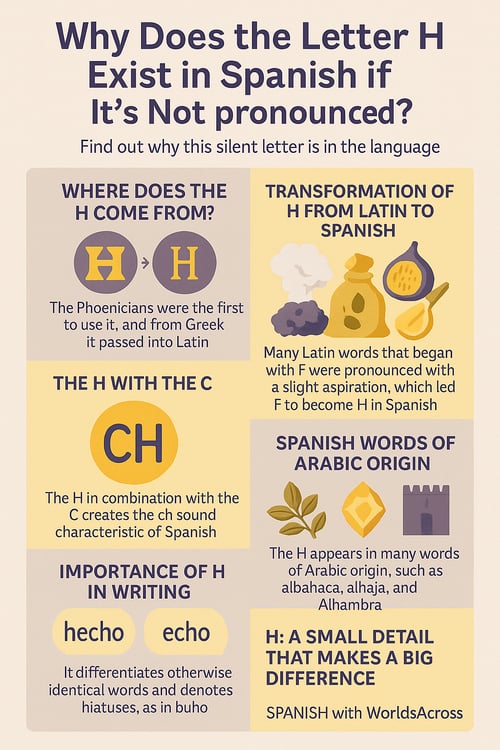
Have you ever wondered why we have the letter H in Spanish if it’s not pronounced? It’s one of those questions many students at WorldsAcross have asked at some point. The truth is, even native speakers get confused by this letter—especially when learning to write. Imagine this: you’re in class, doing a dictation, and you wonder, “Does this word have an H or not?” And it’s not just students who struggle with this. Famous writers and scholars like Gabriel García Márquez and Andrés Bello once suggested that the H should be removed from the alphabet. Even the Royal Spanish Academy has considered the idea! But for some reason, the letter H in Spanish has stuck around and is still with us.
Where Does the H Come From?
To understand why the letter H is in our alphabet, we have to go back in history. Although today the H is silent in most Spanish words, that wasn’t always the case. The Phoenicians, who were the first to use it, pronounced it with a soft exhalation of air—similar to the English H. Later, the Greeks adopted the letter, and from there it passed into Latin. As Latin evolved, the sound of the H began to soften until, in many cases, it disappeared entirely.

The Transformation of H from Latin to Spanish
When Spanish began to form from Latin, the H was preserved in some words. For example, hominem became hombre and habēre became haber. But here’s something curious: Spanish also adopted many Latin words that started with F, like fumo (which became humo) and farina (which became harina). In some regions of Spain, the F was pronounced with a slight aspiration, which led over time to the F being replaced by an H. That’s how many Spanish words ended up with the H that confuses us so much today!
Examples of Spanish Words with H That Used to Start with F:
- Humo (Smoke) – Originally fumo in Latin.
- Harina (Flour) – From farina.
- Higo (Fig) – Previously figo.
- Hacer (To Do) – Comes from facere.
The H with the C
Although the H is usually silent, there’s one case where it teams up with another letter to make a special sound: the combination of H and C. This pair creates the ch sound, which is a hallmark of Spanish. Words like chico (boy), muchacho (young man), and leche (milk) clearly show how this duo works together.
Examples of Words with CH:
- Chico (Boy)
- Muchacha (Girl)
- Chocolate (Chocolate)
- Churro (Fritter)
Spanish Words of Arabic Origin
The H also appears in many words of Arabic origin that entered Spanish during the time of Muslim rule in the Iberian Peninsula. These words have enriched the Spanish vocabulary.
Some examples include:
- Albahaca (Basil) – From Arabic ḥabaqah.
- Alhaja (Jewel) – From Arabic ḥaǧar, meaning stone.
- Alhambra (The Red One) – Derived from Arabic al-ḥamrāʼ.
The Importance of H in Writing
Even though we don’t pronounce it, the letter H in Spanish plays a crucial role in writing. It helps distinguish between words that sound the same but have different meanings. For example, hola (hello) and ola (wave) sound alike, but thanks to the H, we can tell them apart in writing. It also helps indicate hiatos (hiatuses), where two vowels are pronounced in separate syllables, as in búho (owl).
Examples of Words Differentiated by H:
- Hecho (Fact) vs. Echo (I throw)
- Hojear (To leaf through) vs. Ojear (To glance at)
- Halla (Finds) vs. Haya (Beech tree or subjunctive form of "haber")
These examples show just how important H is in Spanish.
H: A Small Detail That Makes a Big Difference
The letter H in Spanish is a mysterious and fascinating letter that, even though it’s silent most of the time, holds an important place in the language. Its history reflects the evolution of Spanish, and its presence in writing helps us communicate clearly. So next time you see a word with an H in Spanish, remember it has a rich history and a purpose. Keep practicing how to use it, and join our learning community at WorldsAcross to keep learning together!




